
Eucalyptus is a genus of more than 700 species of flowering plants in the family Myrtaceae. Most species of Eucalyptus are trees, often mallees, and a few are shrubs. Along with several other genera in the tribe Eucalypteae, including Corymbia and Angophora, they are commonly known as eucalypts or "gum trees". Plants in the genus Eucalyptus have bark that is either smooth, fibrous, hard or stringy, the leaves have oil glands, and the sepals and petals are fused to form a "cap" or operculum over the stamens. The fruit is a woody capsule commonly referred to as a "gumnut".

Biological control or biocontrol is a method of controlling pests, whether pest animals such as insects and mites, weeds, or pathogens affecting animals or plants by using other organisms. It relies on predation, parasitism, herbivory, or other natural mechanisms, but typically also involves an active human management role. It can be an important component of integrated pest management (IPM) programs.
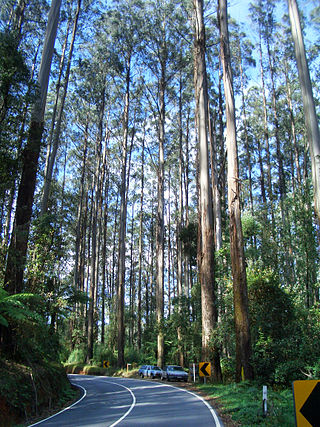
Eucalyptus regnans, known variously as mountain ash, swamp gum, or stringy gum, is a species of medium-sized to very tall forest tree that is native to the Australia states of Tasmania and Victoria. It is a straight-trunked tree with smooth grey bark, but with a stocking of rough brown bark at the base, glossy green, lance-shaped to curved adult leaves, flower buds in groups of between nine and fifteen, white flowers, and cup-shaped or conical fruit. It is the tallest of all flowering plants; the tallest measured living specimen, named Centurion, stands 100 metres tall in Tasmania.

The insects of the beetle family Chrysomelidae are commonly known as leaf beetles, and include over 37,000 species in more than 2,500 genera, making up one of the largest and most commonly encountered of all beetle families. Numerous subfamilies are recognized, but the precise taxonomy and systematics are likely to change with ongoing research.

Bookworm is a general name for any insect that is said to bore through books.

Eucalyptus grandis, commonly known as the flooded gum or rose gum, is a tall tree with smooth bark, rough at the base fibrous or flaky, grey to grey-brown. At maturity, it reaches 50 metres tall, though the largest specimens can exceed 80 metres tall. It is found on coastal areas and sub-coastal ranges from Newcastle in New South Wales northwards to west of Daintree in Queensland, mainly on flat land and lower slopes, where it is the dominant tree of wet forests and on the margins of rainforests.

Paropsis is a genus of Chrysomelidae, commonly referred to as tortoise beetles, which includes over 70 described species. Their small size, bright colours and patterns, and roughly hemispherical shape cause them to be mistaken for beetles in the family Coccinellidae (ladybirds). They are distributed across Australia, New Zealand and Papua New Guinea. Some species, Paropsis atomaria in particular, have been introduced to the United States in California with first official documented sightings in 2022. They primarily feed on Eucalyptus but there are a few that feed on Baeckea, Kunzea and Leptospermum. Species within this genus are noted as pests. For example, Paropsis charybdis is a pest of Eucalyptus in New Zealand.

Abantiades latipennis, known as the Pindi moth, is a species of moth in the family Hepialidae. It may also be referred to as a swift moth or a ghost moth, as this is a common name associated with Hepialidae. Endemic to Australia and identified in 1932, it is most populous in temperate rainforest where eucalypti are prevalent, as the larvae feed primarily on the roots of these trees. Females lay eggs during flight in a scattering fashion. The larvae live for over eighteen months underground, while adult moths survive for approximately one week, as they have no mouthparts with which to feed. The moths are preyed upon by a number of predators, including bats and owls. Brown in colour overall, males are paler and the identifying silver bars of the male's wings are more prominent than those of the female's, with dark margins. Male adults are generally smaller.
Ichneumenoptera chrysophanes, the clearwing persimmon borer, is a moth of the family Sesiidae. It is found from Cairns in Queensland to Canberra in the Australian Capital Territory.
Anaphes nitens is a species of fairyfly, a chalcid wasp in the family Mymaridae. Native to Australia, it is an egg parasitoid of the gum tree snout beetle, a pest of Eucalyptus trees, and has been used in biological pest control of that species.
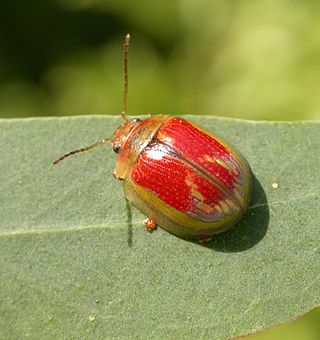
Paropsisterna selmani, the Tasmanian Eucalyptus Beetle, is a species of leaf beetle native to Tasmania which has been inadvertently introduced to the Republic of Ireland and United Kingdom. It is the first eucalyptus-feeding chrysomelid known to have become established in Europe.
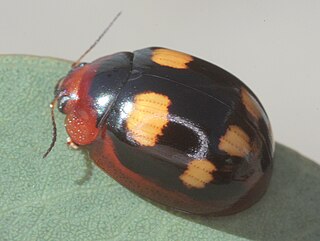
Paropsisterna is a genus of leaf beetles indigenous to Papua New Guinea and Australia. There are over 120 species, many with bright aposematic colours, and many feeding on Eucalyptus leaves.

Paropsides is a genus of beetles commonly called leaf beetles and in the subfamily Chrysomelinae. They are distributed from eastern Asia to eastern Australia. Paropsides are small and specialist feeders on native Australian plants. There are 21 species in Australia and they occur mainly on the south-eastern states. The green Paropsides calypso is a native species which commonly attacks the lillipilli genus Syzygium. Paropsides opposita feeds on Tea tree Melaleuca sp.
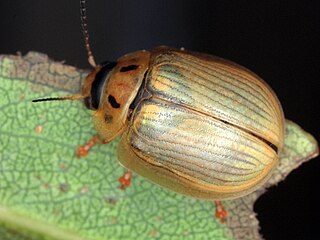
Paropsisterna bimaculata is a beetle commonly called a leaf beetle in the subfamily Chrysomelinae. This insect is common in Tasmania and can be a pest in the forestry industry. Paropsisterna bimaculata will develop a red colour just before their winter hibernation. When they emerge the red slowly disappears into a pale green colouring with faint gold tessellation. This takes about a month with the males generally slightly advanced. Recently this beetle has been noticed in Victoria.

Paropsisterna m-fuscum is a beetle commonly called a leaf beetle in the subfamily Chrysomelinae, and native to Australia. This insect can become very prolific and is a serious pest species in the forestry industry. This beetle is an invasive species and a problem on Blue Gum in California, USA. The beetles are pale, with variable brown markings on the elytra and pronotum and sometimes with bright flaring at the base of the elytra. The larvae are pale green like the leaves they eat.

Aporocera is a genus of leaf beetles commonly called case bearing leaf beetles in the subfamily Cryptocephalinae. Aporocera are well represented in all states of Australia and consist of 148 species in two subspecies.

Hypomeces pulviger, also known as the gold-dust weevil or green weevil, is a species of beetle in the true weevil family. The adult weevil can reach a length of about 14 mm (0.6 in) and is covered with iridescent green or yellowish-green dust-like scales all over the body. This species can be found in India, tropical Southeast Asia, and the Philippines. Both the larvae and adults are crop pests. The larvae live in and pupate in the soil, feeding on living plant roots. The adult weevils are long-lived, doing damage to foliage, and sometimes defoliating young bushes and nursery trees.

Cosmopolites sordidus, commonly known as the banana root borer, banana borer, or banana weevil, is a species of weevil in the family Curculionidae. It is a pest of banana cultivation and has a cosmopolitan distribution, being found in all parts of the world in which bananas are grown. It is considered the most serious insect pest of bananas.
Cadmus (Brachycaulus) colossus, or Cadmus colossus, is a species of beetle in the subfamily, Cryptocephalinae, or case-bearing leaf beetles, and the subgenus, Brachycaulus. It was first described by Félicien Chapuis in 1875, from a male specimen collected at Port Denison. It is native to Australia, being found in New South Wales and Queensland.
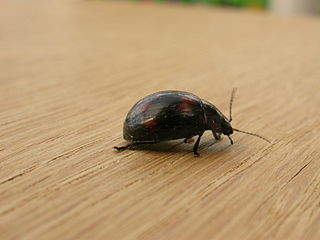
Paropsisterna beata, commonly known as the blessed leaf beetle, is a species of leaf beetle. It occurs in all states of Australia except Tasmania.

















